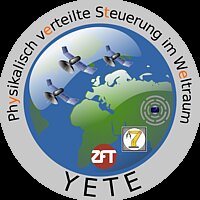YETE

State of the Art in Satellite data processing
One very important design decision in modern satellite systems is how the onboard data handling is done. More specific, how sensor data or payload data is processed, evaluated and eventually used again to compute new commands for the satellite actuators. A very common approach to onboard data processing, which is widely employed, is done in three steps. First the sensor data is preprocessed with specialized processors, which directly belong the the individual sensors. Secondly the outcoming data is processed, together with additional information, e.g. from the ground station, on one of the redundant onboard processors. Finally the computed control commands are sent to the specialized preprocessors of the actuators, which then react accordingly. One of the drawbacks of this approach is, that due to preprocessing done on a per sensor/actuator basis, a lot of different processing units are needed, which only serve single purpose. If such a preprocessing unit fails, the whole sensor/acutator is lost for the satellite. Furthermore processing units of sensors which are not needed momentarily still consume power, instead of lending their computational capabilities to other currently needed data processing tasks.
Project Description
The „Physikalisch verteilte Steuerung im Weltraum“ (YETE) project wants to demonstrate the feasability of a new approach to satellite data processing. The Idea is to break the strong coupling between the sensors/actuators and their corresponding preprocessors and instead do the preprocessing of the raw sensor data and other computations in an onboard computing cluster of general purpose processors. All components are wireless linked, which allows the computing cluster to extend over the intra satellite border to other satellites, ground stations or even to robot rovers on the ground. The units of the whole rover - ground station - satellite network (RGS-N) employ the sampe principle of general purpose computing units and task distribution and therefore their computational ressources can be shared effectively. This leads to less wasted ressources, greater fault tolerance and a higher efficiency.
Example Scenarios
An usage example would be an unit of the RGS-N, f.e. a satellite, performing a control task which would exceed its own computational capabilities, but is still possible with the help of free ressources of other RGS-N units. The distribution of task computations in the cluster is performed completely transparent to the task itself, which benefits abstraction and task development. Another possible scenario would be a rescue mission, in which a satellite is taking over the actuators and sensors of another satellite, whose CPU's are damaged, to control the attitude and orbit of the damaged satellite or to read diagnose information from its sensors. In the scope of the YETE project, this new concept will be implemented and demonstrated on a hardware platform which contains similiar computation units as employed in typical rovers, satellites and ground stations. In a later stage of the project the concept implementation will be run on selected satellites, ground stations and rovers.
Sponsor
The YETE project is funded 100% by the DLR-Agency. Förderkennzeichen: 50RA1330
Contacts
For detailed information about the YETE project and opportunities to work for the project, interested people are requested to approach the team members:
Head of the project: Prof. Dr. Klaus Schilling schi@informatik.uni-wuerzburg.de +49-931-31-86647


